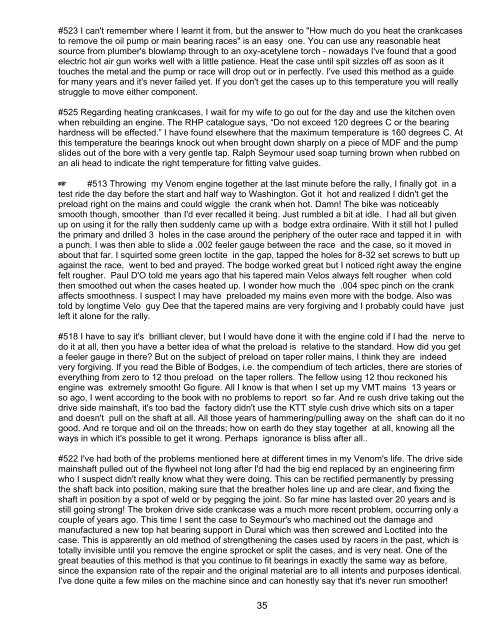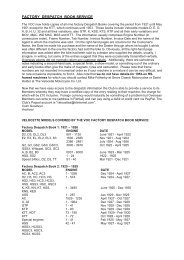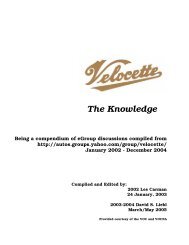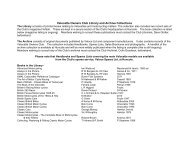The Knowledge - Velocette Owners Club
The Knowledge - Velocette Owners Club
The Knowledge - Velocette Owners Club
You also want an ePaper? Increase the reach of your titles
YUMPU automatically turns print PDFs into web optimized ePapers that Google loves.
#523 I can't remember where I learnt it from, but the answer to "How much do you heat the crankcases<br />
to remove the oil pump or main bearing races" is an easy one. You can use any reasonable heat<br />
source from plumber's blowlamp through to an oxy-acetylene torch - nowadays I've found that a good<br />
electric hot air gun works well with a little patience. Heat the case until spit sizzles off as soon as it<br />
touches the metal and the pump or race will drop out or in perfectly. I've used this method as a guide<br />
for many years and it's never failed yet. If you don't get the cases up to this temperature you will really<br />
struggle to move either component.<br />
#525 Regarding heating crankcases, I wait for my wife to go out for the day and use the kitchen oven<br />
when rebuilding an engine. <strong>The</strong> RHP catalogue says, “Do not exceed 120 degrees C or the bearing<br />
hardness will be effected.” I have found elsewhere that the maximum temperature is 160 degrees C. At<br />
this temperature the bearings knock out when brought down sharply on a piece of MDF and the pump<br />
slides out of the bore with a very gentle tap. Ralph Seymour used soap turning brown when rubbed on<br />
an ali head to indicate the right temperature for fitting valve guides.<br />
L #513 Throwing my Venom engine together at the last minute before the rally, I finally got in a<br />
test ride the day before the start and half way to Washington. Got it hot and realized I didn't get the<br />
preload right on the mains and could wiggle the crank when hot. Damn! <strong>The</strong> bike was noticeably<br />
smooth though, smoother than I'd ever recalled it being. Just rumbled a bit at idle. I had all but given<br />
up on using it for the rally then suddenly came up with a bodge extra ordinaire. With it still hot I pulled<br />
the primary and drilled 3 holes in the case around the periphery of the outer race and tapped it in with<br />
a punch. I was then able to slide a .002 feeler gauge between the race and the case, so it moved in<br />
about that far. I squirted some green loctite in the gap, tapped the holes for 8-32 set screws to butt up<br />
against the race, went to bed and prayed. <strong>The</strong> bodge worked great but I noticed right away the engine<br />
felt rougher. Paul D'O told me years ago that his tapered main Velos always felt rougher when cold<br />
then smoothed out when the cases heated up. I wonder how much the .004 spec pinch on the crank<br />
affects smoothness. I suspect I may have preloaded my mains even more with the bodge. Also was<br />
told by longtime Velo guy Dee that the tapered mains are very forgiving and I probably could have just<br />
left it alone for the rally.<br />
#518 I have to say it's brilliant clever, but I would have done it with the engine cold if I had the nerve to<br />
do it at all, then you have a better idea of what the preload is relative to the standard. How did you get<br />
a feeler gauge in there? But on the subject of preload on taper roller mains, I think they are indeed<br />
very forgiving. If you read the Bible of Bodges, i.e. the compendium of tech articles, there are stories of<br />
everything from zero to 12 thou preload on the taper rollers. <strong>The</strong> fellow using 12 thou reckoned his<br />
engine was extremely smooth! Go figure. All I know is that when I set up my VMT mains 13 years or<br />
so ago, I went according to the book with no problems to report so far. And re cush drive taking out the<br />
drive side mainshaft, it's too bad the factory didn't use the KTT style cush drive which sits on a taper<br />
and doesn't pull on the shaft at all. All those years of hammering/pulling away on the shaft can do it no<br />
good. And re torque and oil on the threads; how on earth do they stay together at all, knowing all the<br />
ways in which it's possible to get it wrong. Perhaps ignorance is bliss after all..<br />
#522 I've had both of the problems mentioned here at different times in my Venom's life. <strong>The</strong> drive side<br />
mainshaft pulled out of the flywheel not long after I'd had the big end replaced by an engineering firm<br />
who I suspect didn't really know what they were doing. This can be rectified permanently by pressing<br />
the shaft back into position, making sure that the breather holes line up and are clear, and fixing the<br />
shaft in position by a spot of weld or by pegging the joint. So far mine has lasted over 20 years and is<br />
still going strong! <strong>The</strong> broken drive side crankcase was a much more recent problem, occurring only a<br />
couple of years ago. This time I sent the case to Seymour's who machined out the damage and<br />
manufactured a new top hat bearing support in Dural which was then screwed and Loctited into the<br />
case. This is apparently an old method of strengthening the cases used by racers in the past, which is<br />
totally invisible until you remove the engine sprocket or split the cases, and is very neat. One of the<br />
great beauties of this method is that you continue to fit bearings in exactly the same way as before,<br />
since the expansion rate of the repair and the original material are to all intents and purposes identical.<br />
I've done quite a few miles on the machine since and can honestly say that it's never run smoother!<br />
35





